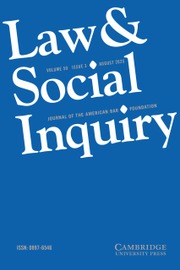Article contents
Legal Strategies at the Governance Precipice: Transnational Lawyers in the European Union’s Sovereign Debt Crisis (2010–2012)
Published online by Cambridge University Press: 06 November 2023
Abstract
How do transnational lawyers valorize their expertise in a political and economic crisis? This article argues that knowing how transnational lawyers valorize their expertise is critical to understanding how transnational law evolves and affects society, especially when existing legal frameworks prove to be inadequate and novel practices must pave new paths. Using the acute phase of the Eurozone crisis between 2010 and 2012 as an empirical case, I examine how European Union (EU) legal agents constructed a framework that accommodated the uncertainty of governing a crisis while also mediating the contentious politics between EU Member States. The analysis shows that as intergovernmental bargaining dominates Eurozone crisis governance, EU legal advisors intervene to reconcile these bargains with the EU legal order using novel practices that simultaneously valorize their legal expertise. These practices in effect engender a high degree of interdependence and interconnection between the EU legal order and several intergovernmental arrangements—especially the European Stability Mechanism—leading to the creation of a unique form of EU governance: semi-intergovernmentalism. This article contributes to debates on legal globalization by empirically examining how transnational legal agents valorize their expertise through strategies directed at defending their autonomy while protecting the normative coherence of their transnational legal order: the EU.
- Type
- Articles
- Information
- Copyright
- © The Author(s), 2023. Published by Cambridge University Press on behalf of the American Bar Foundation
Footnotes
Nicholas Haagensen would like to thank Mikael Rask Madsen, Antoine Vauchez, Leonard Seabrooke, Ramona Coman, Jacob Hasselbalch, colleagues at iCourts, and the anonymous reviewers for their insightful comments on earlier drafts. Research for this article was done under the GEM-STONES programme, which was supported by the European Union’s Horizon 2020 research and innovation programme under the Marie Sklodowska-Curie Grant Agreement No. 722826.
References
REFERENCES
- 1
- Cited by


